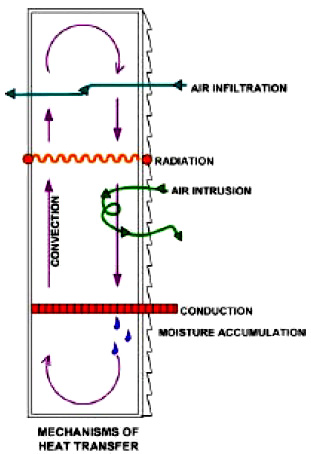Principles of Heat Transfer
Heat loss or gain can occur through an element of the building envelope (wall, floor, or roof/ceiling) by three primary mechanisms:
- 1. Conduction
- 2. Convection
- 3. Radiation
In addition, three secondary mechanisms can influence the heat loss/gain by affecting insulation effectiveness:
- 4. Air Infiltration
- 5. Air Intrusion
- 6. Moisture Accumulation
R-Value, the traditional measure of an insulation's effectiveness, measures only one of these six mechanisms.
CONDUCTION
Conduction is the transfer of heat within an object or between two objects in contact. For heat to conduct from one object to another, they must be in contact: break the contact and conduction ends. Conventional R-value tests measure conduction only.
Example: A metal pipe penetrating a wall will conduct heat through the wall and bypass the insulation system (this is often call "thermal bridging.")
Spray polyurethane foam: The predominant heat transfer mechanism for spray foam is conduction. However, because the polymer matrix and the gas contained within the cells are both poor conductors of heat, closed cell spray polyurethane foam has a very high R-value and effectively blocks heat transfer by conduction.
CONVECTION
Convective heat transfer occurs when a liquid or gas (fluids) comes in contact with a material of a different temperature. Natural convection occurs when the flow of a liquid or gas is primarily due to density differences within the fluid due to heating or cooling of that fluid. Forced convection occurs when the flow of fluid (liquid or gas) is primarily due to pressure differences.
Within a stud wall cavity, "convective loops" will occur when the exterior and interior temperatures are different. For example, if the interior is warm and the exterior cold, air within the cavity in contact with the exterior wall will cool, becoming denser, and flow downward. Conversely, air in contact with the interior wall will warm, becoming less dense, and rise. Air rising and falling within the wall cavity forms a "loop" which transfers heat from the warm wall to the cold wall. The result is increased heat loss/gain. By stopping the air movement, convective heat loss will cease.
The primary insulating mechanism of conventional insulations (glass fiber and cellulose) is to slow this convective looping. These insulation products work by resisting the fluid flow of natural convective loops. (Note: As the temperature difference increases between the wall surfaces, the rate of air flow in these natural convective loops increases and the effective Rvalues of conventional insulations decrease.)
Spray polyurethane foam: Closed-cell spray foam eliminates air movement within the insulation eliminating convection as a heat transfer mechanism within the insulation mass.

RADIATION
Radiation is the transfer of heat from one object to another by means of electro-magnetic waves. Radiative heat transfer does not require that objects be in contact or that a fluid flow between those objects. Radiative heat transfer occurs in the void of space (that's how the sun warms us).
People in a room at 72ºF air temperature may feel uncomfortably cold if the walls and ceiling are at 50ºF. Conversely, they may feel uncomfortably warm if the walls are 85ºF. Even though the air temperature is the same in both cases, the radiative cooling or warming of their bodies relative to the walls and ceiling will affect their comfort level (people sense heat loss or gain, not temperature).
Spray polyurethane foam: Heat transfer by radiation is effectively blocked by spray foam because of the cell structure. Heat can transfer by radiation across each cell. However, because adjoining cell walls are at essentially the same temperature, heat transfer by radiation is practically nonexistent. Additionally, the interior sides of walls insulated with spray foam tend to be nearly the same temperature as the room; therefore, radiant heat loss/gain to room occupants is minimal leading to greater comfort.
AIR INFILTRATION
Air infiltration, in essence, bypasses insulation. It transfers heat by the gross flow of air between the exterior and the interior. The underlying force behind air infiltration is the air pressure difference between the exterior and the interior. Air pressure differences can be caused by wind or stack effect.
Air infiltration may be eliminated by air sealing the building envelope. Conventional insulations traditionally use "house wraps" in an attempt to air seal the building envelope. Vapor retarders may also serve to reduce air infiltration.
Air infiltration can be measured using the "Blower Door Test": ASTM E 779 Standard Test Method for Determining Air Leakage Rate by Fan Pressurization. A fan is installed in an exterior door of the house to be tested (and all the other doors, windows, etc. are closed or sealed). The fan speed is adjusted to create a calibrated pressure differential between the outside air and the inside air. The air flow through the fan needed to maintain this pressure difference is measured and used to determine the air leakage rate.
Spray polyurethane foam: Air will not penetrate spray foam under pressure differences buildings normally experience. Even open-celled spray foams effectively stop air infiltration. The ability of spray foam to adhere to substrates and expand in place allow spray foam to seal cracks and crevasses. Stopping air infiltration is one of spray polyurethane foam's greatest assets.
AIR INTRUSION
Air intrusion is also called "wind wash." Unlike air infiltration, wherein air moves from the exterior to the interior, air intrusion occurs when air enters the insulation from the exterior and exits back to the exterior. There is no drafting of air to the interior of the building but the thermal gradient of the insulation is disrupted. In effect, air intrusion introduces forced convection into the building envelope (wall, ceiling, etc.). Air intrusion is caused by wind.
Air intrusion can substantially undermine the effective R-value of conventional insulations. Air intrusion can occur independently of air infiltration. Like air infiltration, house wraps are traditionally used with conventional insulation systems to attempt to reduce air intrusion. Vapor retarders installed on the interior side of the building envelope will not affect air intrusion.
Spray polyurethane foam: For the same reasons spray foam stops air infiltration, it will stop air intrusion.
MOISTURE ACCUMULATION
Moisture accumulation within insulation materials will reduce that insulation's R-value, contributing to heat loss/gain. Moisture accumulation can be controlled with effective air barriers, vapor retarders or "flow through" designs (which allow moisture transfer without condensation).
Spray polyurethane foam: Closed-cell spray foam stops moisture accumulation due to air infiltration and air intrusion. In addition, closed-cell spray polyurethane foam retards both heat transfer and water vapor transfer making it an ideal material for use with flow-through designed building assemblies.
SUMMARY
Closed-cell spray polyurethane foam effectively blocks the
three primary and the three secondary mechanisms of heat
transfer, offering insulation efficiencies well beyond that
suggested by its high R-value alone. Spray foam's insulating
efficiency remains high when other insulations' efficiencies drop
due to wind, high temperature differences, and moisture.
FREE Estimate






